Analysis of Thermal Aging Influence on Selected Physical and Mechanical Characteristics of Polyaddition and Polycondensation Poly(dimethylsiloxane)
Abstract
:1. Introduction
2. Research
3. Materials and Methods
- addition type: RTV 3428 (marked AA) by Elkem (Warsaw, Poland), ZA 28 (AB) (Zhermack Industrial (Warsaw, Poland)) and HT 33 (AC) (Zhermack Industrial (Warsaw, Poland)), RTV 3040SB (AD) (Elkem (Warsaw, Poland))
- condensation type: RTV 3318 (KE) (Elkem (Warsaw, Poland)), RTV 3325 (KF) (Elkem (Warsaw, Poland)), which can be used as molding materials for parts with complex geometry.
3.1. Density
3.2. Hardness
3.3. Mechanical Testing
3.4. Roughness
3.5. Dynamic Mechanical Analysis (DMA)
3.6. Fourier Transform Infrared Spectroscopy (FTIR)
3.7. Accelerated Thermal Aging
4. Results
4.1. Density
4.2. Hardness
4.3. Mechanical Testing
4.4. Roughness
4.5. Dynamic Mechanical Analysis (DMA)
4.6. Fourier Transform Infrared Spectroscopy (FTIR)
5. Conclusions
- Thermal aging slightly affects the density of polyadditive and polycondensation silicones. A minor decrease in this value was observed. The change is minor and falls within the error margin.
- Thermal aging affects the change in Shore A hardness values. For polyadditive PDMS, there is a noticeable increase in the average hardness value, which is likely related to their long chains in the structure, in which further cross-linking of the structure occurs as a result of high temperature. Polycondensation PDMS show a decrease in average hardness values after thermal aging. This is likely due to a different structural build of the materials compared to polyadditive PDMS, where the chains are shorter and less resistant to external factors, such as a high temperature during which they break apart.
- The change in tensile strength results is conditioned by the type of material. In polyadditive PDMS, similar to the hardness results, the tensile strength increases and the greatest average increase in this value was observed for polyadditive silicones AC (3.4%) and AD (3.2%), which are characterized by higher initial hardness compared to other polyadditive silicones. Polycondensation silicones also show a change, but it is decreasing. In the case of polycondensation silicones, a greater average change in tensile strength value can be observed for the KF material (14.3%), which is characterized by a higher initial Shore A hardness value.
- Regardless of the type of material, a decrease in the average value of relative elongation is noticeable. From the obtained results, it can be concluded that the value of relative elongation in polyadditive PDMS depends on the viscosity of the material, as a much larger change in this value was observed for materials with lower viscosity. The greatest change in this value occurs for polyadditive PDMS materials AB (46.7%) and AC (49.7%).
- The effect of high temperature on the tested materials results in a minor change in surface roughness compared to reference materials. A comparable change occurs in both polyadditive and polycondensation PDMS.
- AC and AD materials, which are characterized by higher initial hardness (before thermal aging), have a higher storage modulus G’ than materials with lower hardness.
- For the polyadditive PDMS AA, an increase in the intensity of the Si-O-Si band was observed while for AB, there was an increase in the intensity of the Si-CH3 and Si(CH3)2 bands, which may be related to the increase in tensile strength or hardness results. For the remaining polyadditive silicones AC and AD and polycondensation silicones KE and KF, no significant change in the intensity of individual spectra is visible. It is not possible to unequivocally correlate the obtained spectra results with the results of mechanical tests.
- Essentially, it can be assumed that in the case of condensation PDMS, the observed changes are due to further cross-linking of the material under the influence of high temperature while for addition PDMS, stress relaxation also had a significant impact. The tested PDMS materials show satisfactory resistance to degradation at elevated temperatures. From a technical utilization standpoint of the tested materials, it can be stated that the observed changes will not have a significant impact on the durability and functionality of the products made from them. At the same time, it seems advisable to conduct tests on materials aged over a longer period.
Supplementary Materials
Author Contributions
Funding
Institutional Review Board Statement
Data Availability Statement
Conflicts of Interest
References
- Mitra, A.; Atwood, D.A. Polysiloxanes & Polysilanes: Based in part on the article Polysiloxanes & Polysilanes by Robert West which appeared in the Encyclopedia of Inorganic Chemistry. In Encyclopedia of Inorganic and Bioinorganic Chemistry, 1st ed.; John Wiley & Sons: Hoboken, NJ, USA, 2011. [Google Scholar]
- Zeldin, M. Polymers, Inorganic and Organometallic. In Encyclopedia of Physical Science and Technology; Academic Press: Cambridge, MA, USA, 2003; pp. 675–695. [Google Scholar] [CrossRef]
- Maka, H.; Spychaj, T.; Pilawka, R. Epoxy Resin/Ionic Liquid Systems: The Influence of Imidazolium Cation Size and Anion Type on Reactivity and Thermomechanical Properties. Ind. Eng. Chem. Res. 2012, 51, 5197–5206. [Google Scholar] [CrossRef]
- Alarifi, I.M. Investigation the conductivity of carbon fiber composites focusing on measurement techniques under dynamic and static loads. J. Mater. Res. Technol. 2019, 8, 4863–4893. [Google Scholar] [CrossRef]
- Gu, J.; Yang, X.; Lv, Z.; Li, N.; Liang, C.; Zhang, Q. Functionalized graphite nanoplatelets/epoxy resin nanocomposites with high thermal conductivity. Int. J. Heat Mass Transf. 2016, 92, 15–22. [Google Scholar] [CrossRef]
- Agrawal, A.; Satapathy, A. Effects of aluminium nitride inclusions on thermal and electrical properties of epoxy and polypropylene: An experimental investigation. Compos. Part A Appl. Sci. Manuf. 2014, 63, 51–58. [Google Scholar] [CrossRef]
- Bian, W.; Yao, T.; Chen, M.; Zhang, C.; Shao, T.; Yang, Y. The synergistic effects of the micro-BN and nano-Al2O3 in micro-nano composites on enhancing the thermal conductivity for insulating epoxy resin. Compos. Sci. Technol. 2018, 168, 420–428. [Google Scholar] [CrossRef]
- Wilkie, C.A.; Morgan, A.B. (Eds.) Fire Retardancy of Polymeric Materials; CRC Press: Boca Raton, FL, USA, 2009. [Google Scholar]
- Fabiani, D.; Montanari, G.C.; Laurent, C.; Teyssedre, G.; Morshuis, P.H.F.; Bodega, R.; Dissado, L.A.; Campus, A.; Nilsson, U.H. Polymeric HVDC Cable Design and Space Charge Accumulation. Part 1: Insulation/Semicon Interface. IEEE Electr. Insul. Mag. 2007, 23, 11–19. [Google Scholar] [CrossRef]
- Densley, J. Ageing mechanisms and diagnostics for power cables—An overview. IEEE Electr. Insul. Mag. 2001, 17, 14–22. [Google Scholar] [CrossRef]
- Tanaka, T. Aging of polymeric and composite insulating materials. Aspects of interfacial performance in aging. IEEE Trans. Dielectr. Electr. Insul. 2002, 9, 704–716. [Google Scholar] [CrossRef]
- Mayoux, C. Degradation of insulating materials under electrical stress. IEEE Trans. Dielectr. Electr. Insul. 2000, 7, 590–601. [Google Scholar] [CrossRef]
- Plaček, V.; Bartoníček, B.; Hnát, V.; Otáhal, B. Dose rate effects in radiation degradation of polymer-based cable materials. Nucl. Instrum. Methods Phys. Res. Sect. B Beam Interact. Mater. Atoms 2003, 208, 448–453. [Google Scholar] [CrossRef]
- Silikon HT 33. Available online: https://www.tr-solution.pl/uploads/SILIKONY/HT%2033.pdf (accessed on 2 August 2023).
- Silikon RTV 3040 SB. Available online: https://www.tr-solution.pl/uploads/SILIKONY/BLUESIL%20RTV%203040%20SB.pdf (accessed on 2 August 2023).
- Silikon RTV 3318. Available online: https://www.tr-solution.pl/uploads/SILIKONY/Kondensacyjne/BLUESIL%20RTV%203318.pdf (accessed on 2 August 2023).
- Silikon RTV 3325. Available online: https://www.tr-solution.pl/uploads/SILIKONY/Kondensacyjne/BLUESIL%20RTV%203325.pdf (accessed on 2 August 2023).
- Silikon RTV 3428. Available online: https://www.tr-solution.pl/uploads/SILIKONY/BLUESIL%20RTV%203428.pdf (accessed on 2 August 2023).
- Silikon ZA 28 MOULD. Available online: https://www.tr-solution.pl/uploads/SILIKONY/ZA%2028%20MOULD.pdf (accessed on 2 August 2023).
- ISO 1183-1:2019-05; Plastics—Methods for determining the density of non-porous plastics—Part 1: Immersion method, liquid pycnometer method and titration method. ISO: Geneva, Switzerland, 2019.
- ISO 527-2:2012; Plastics—Determination of tensile properties—Part 2: Test conditions for moulding and extrusion plastics. ISO: Geneva, Switzerland, 2012.
- ISO 527-1:2020-01; Plastics—Determination of mechanical properties under static stretching—Part 1: General principles. ISO: Geneva, Switzerland, 2020.
- ISO 868:2005; Plastics and ebonite—Determination of indentation hardness by means of a durometer (shore hardness). ISO: Geneva, Switzerland, 2005.
- Kumar, D.S.; Shukla, M.J.; Mahato, K.K.; Rathore, D.K.; Prusty, R.K.; Ray, B.C. Effect of post-curing on thermal and mechanical behavior of GFRP composites. IOP Conf. Ser. Mater. Sci. Eng. 2015, 75, 12012. [Google Scholar] [CrossRef]
- Koziol, M.; Mocek, P.; Jankowski, P. Effect of the specimen volume of chemosetting polyester resin on the curing process. Polimery 2016, 61, 133–141. [Google Scholar] [CrossRef]
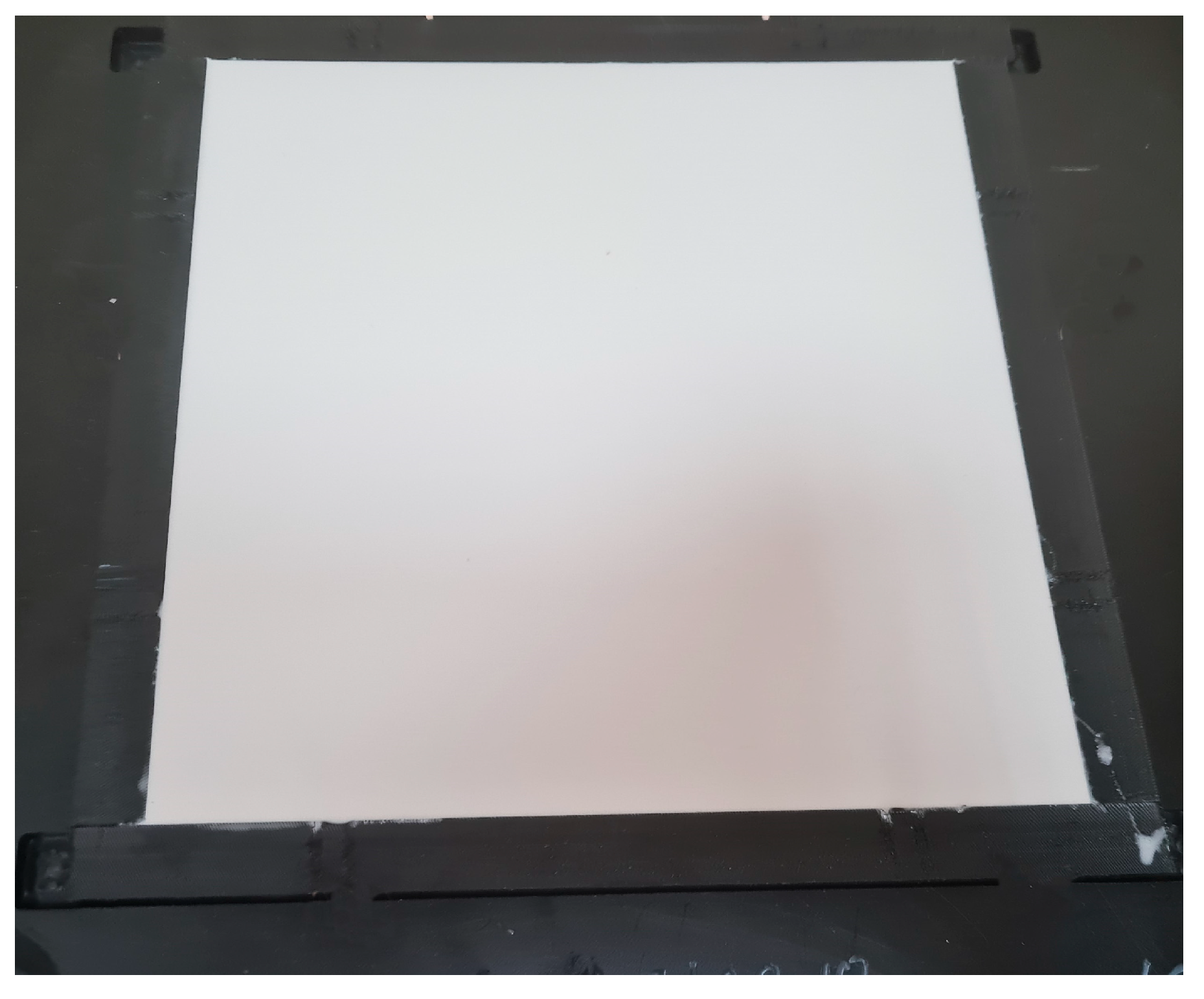
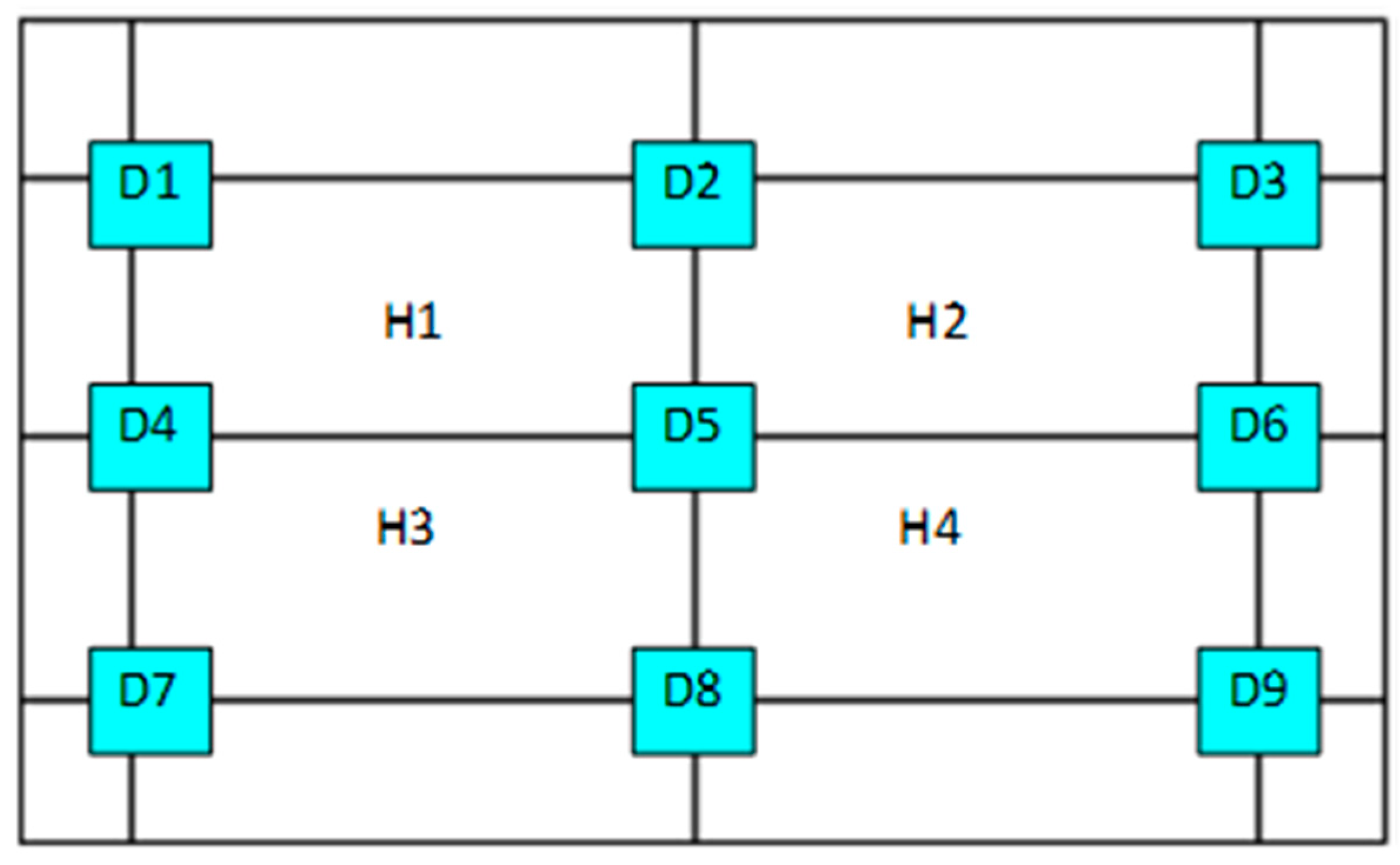
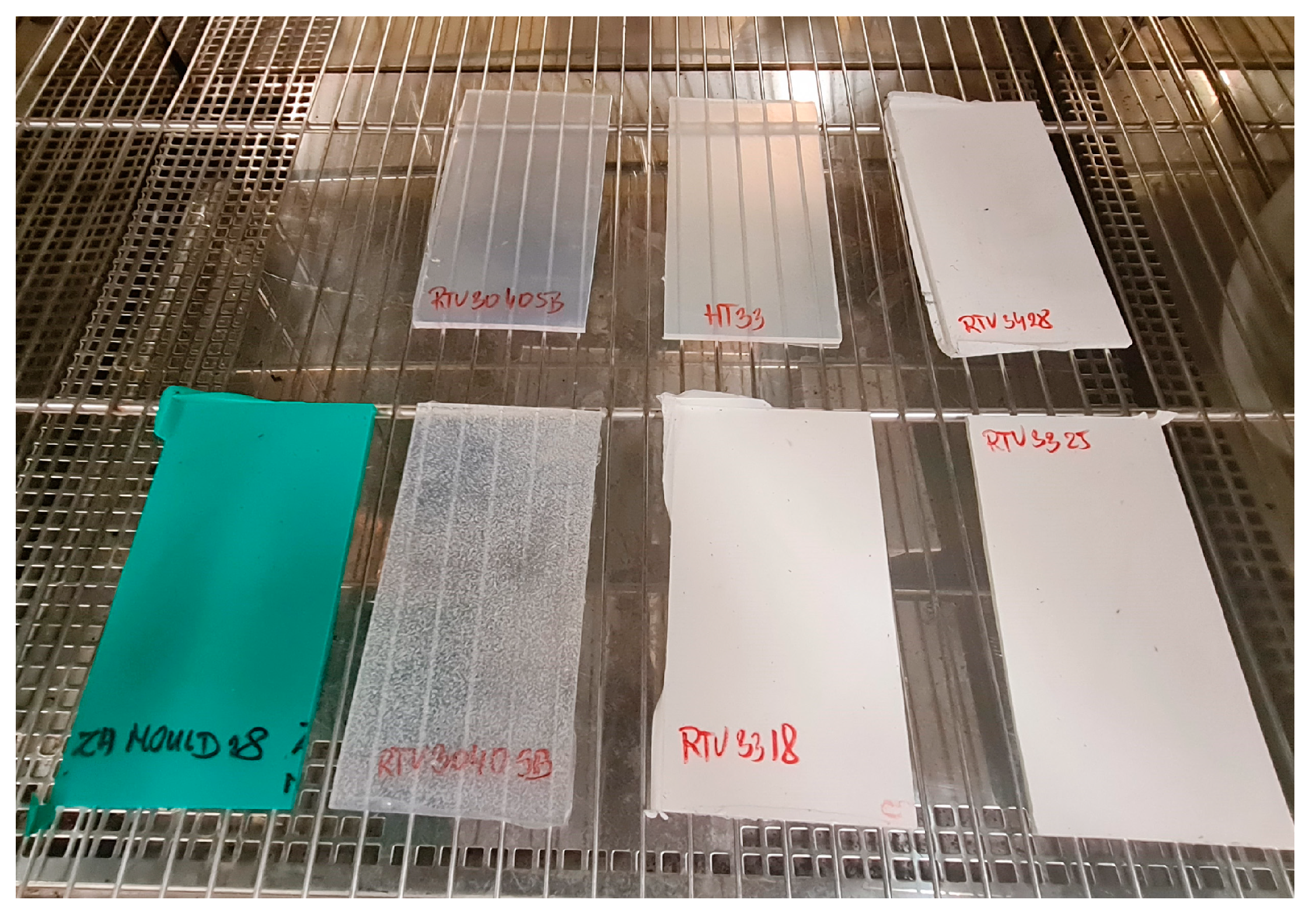

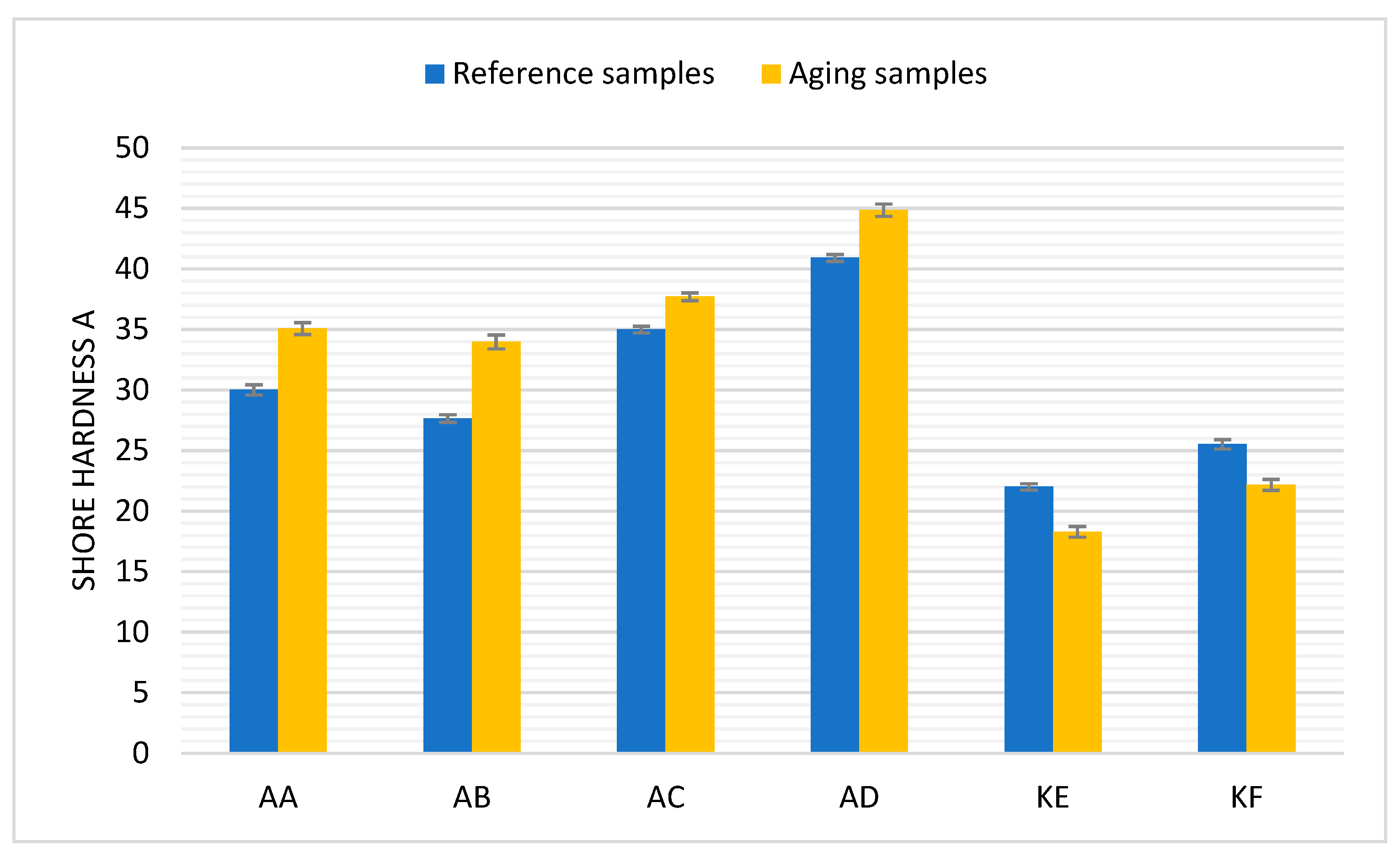
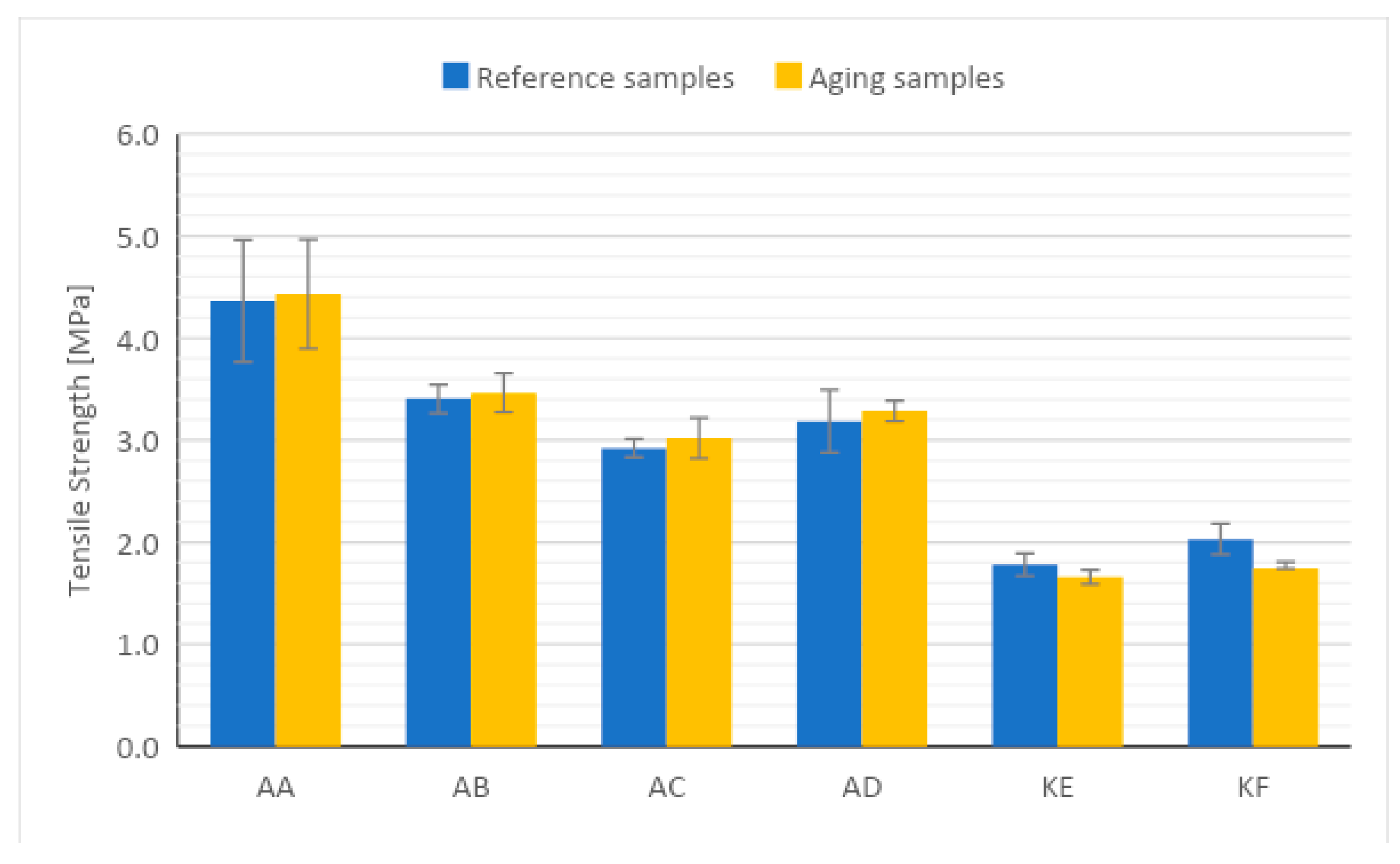
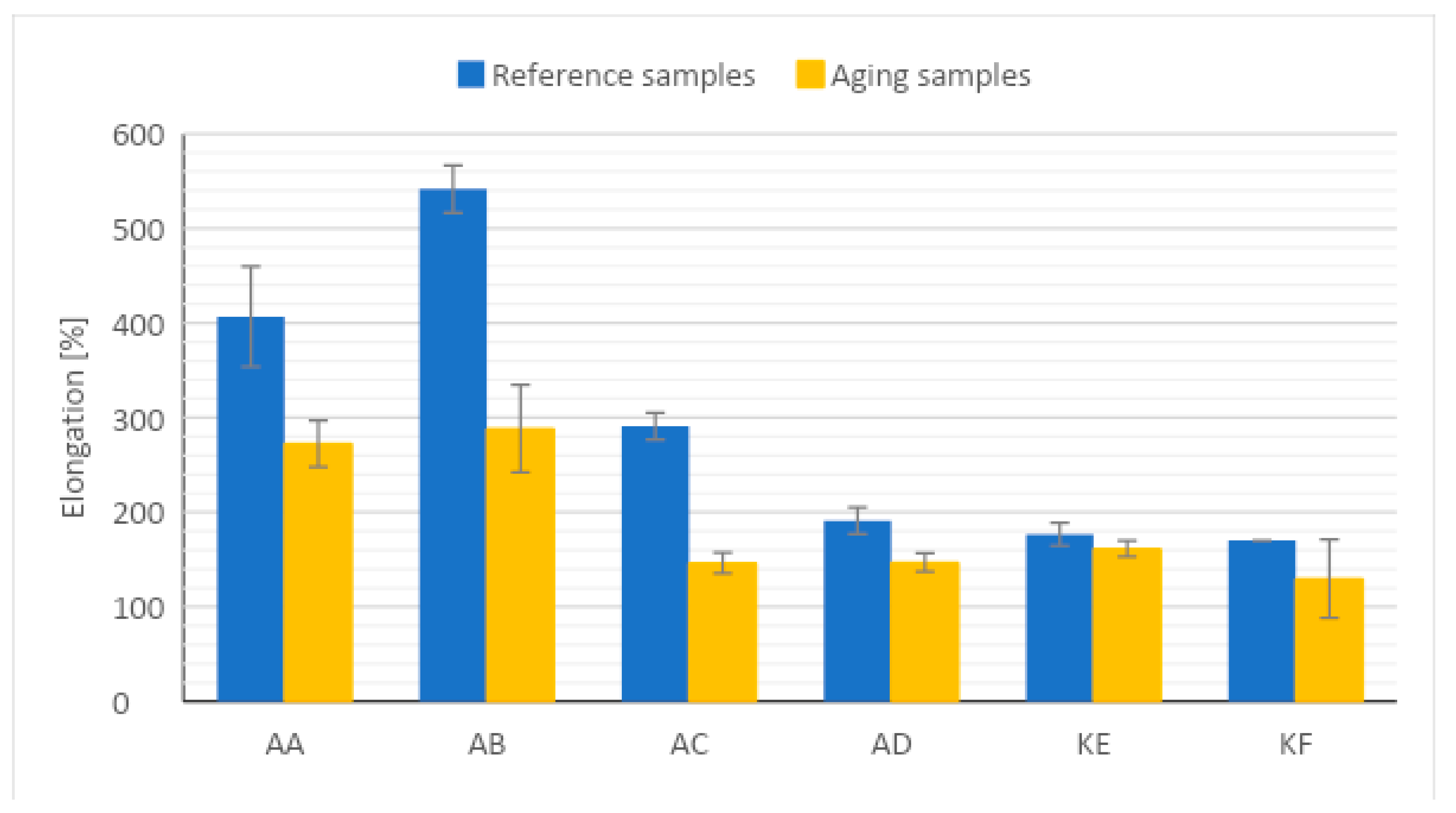

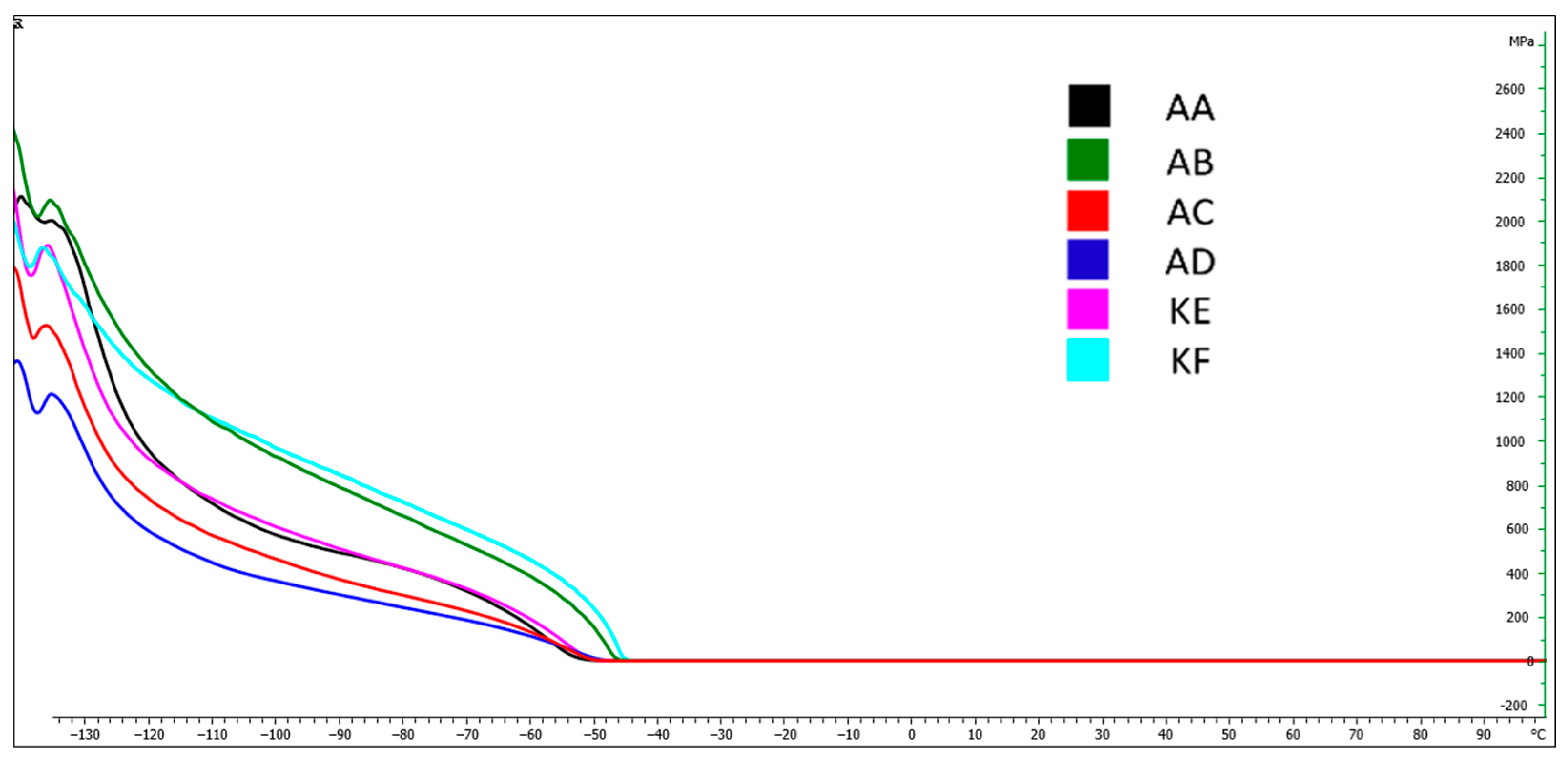
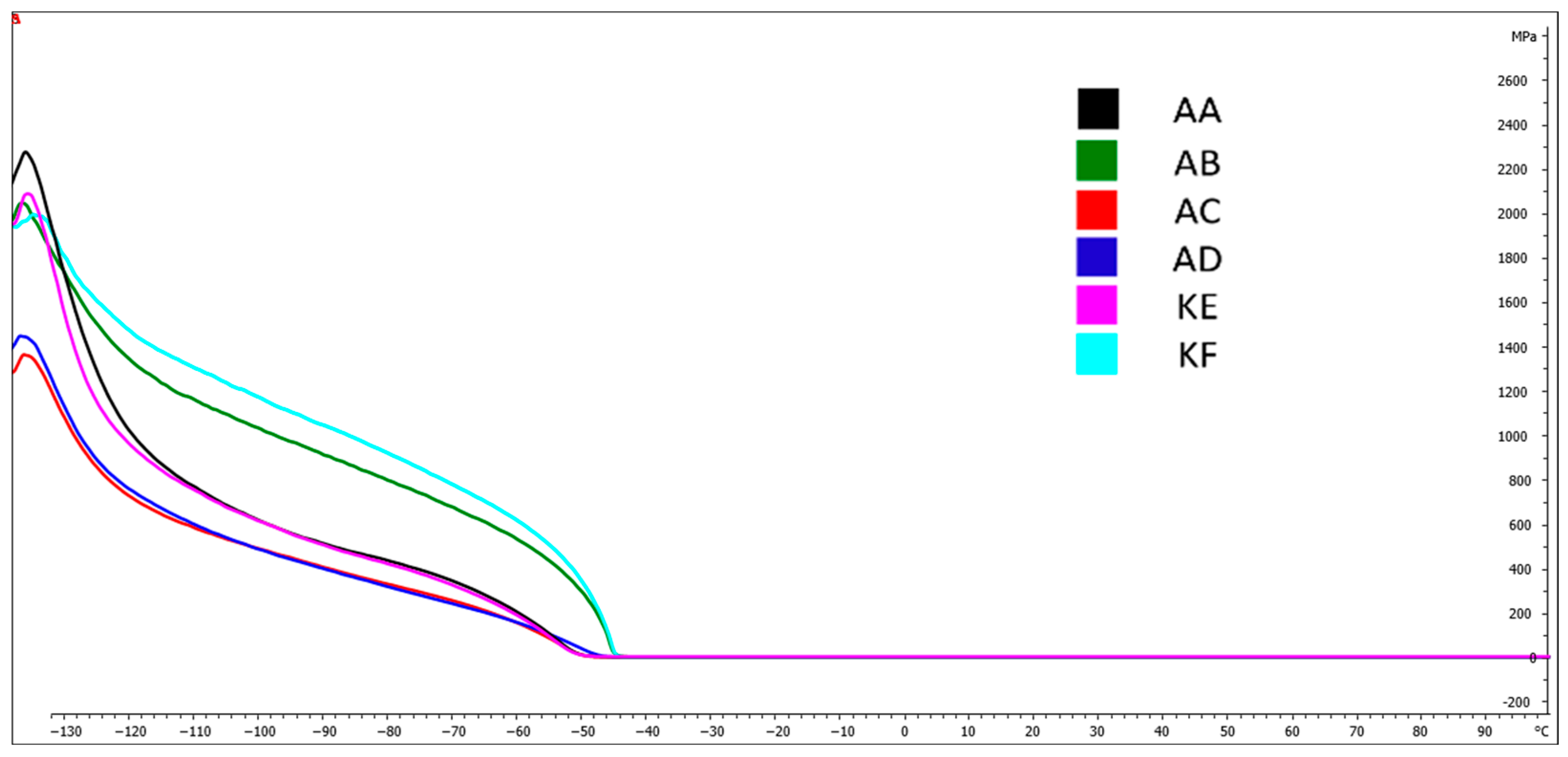
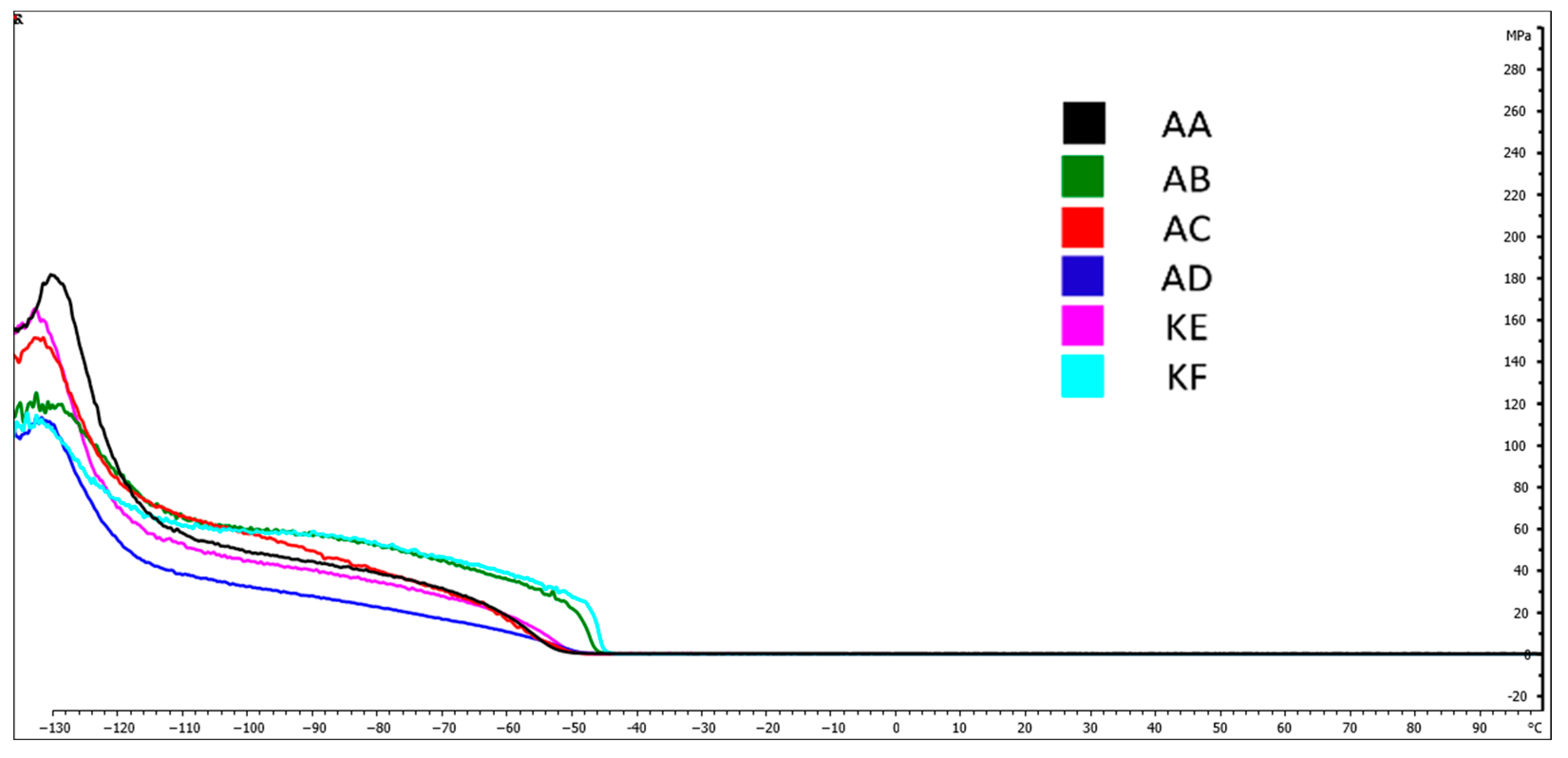
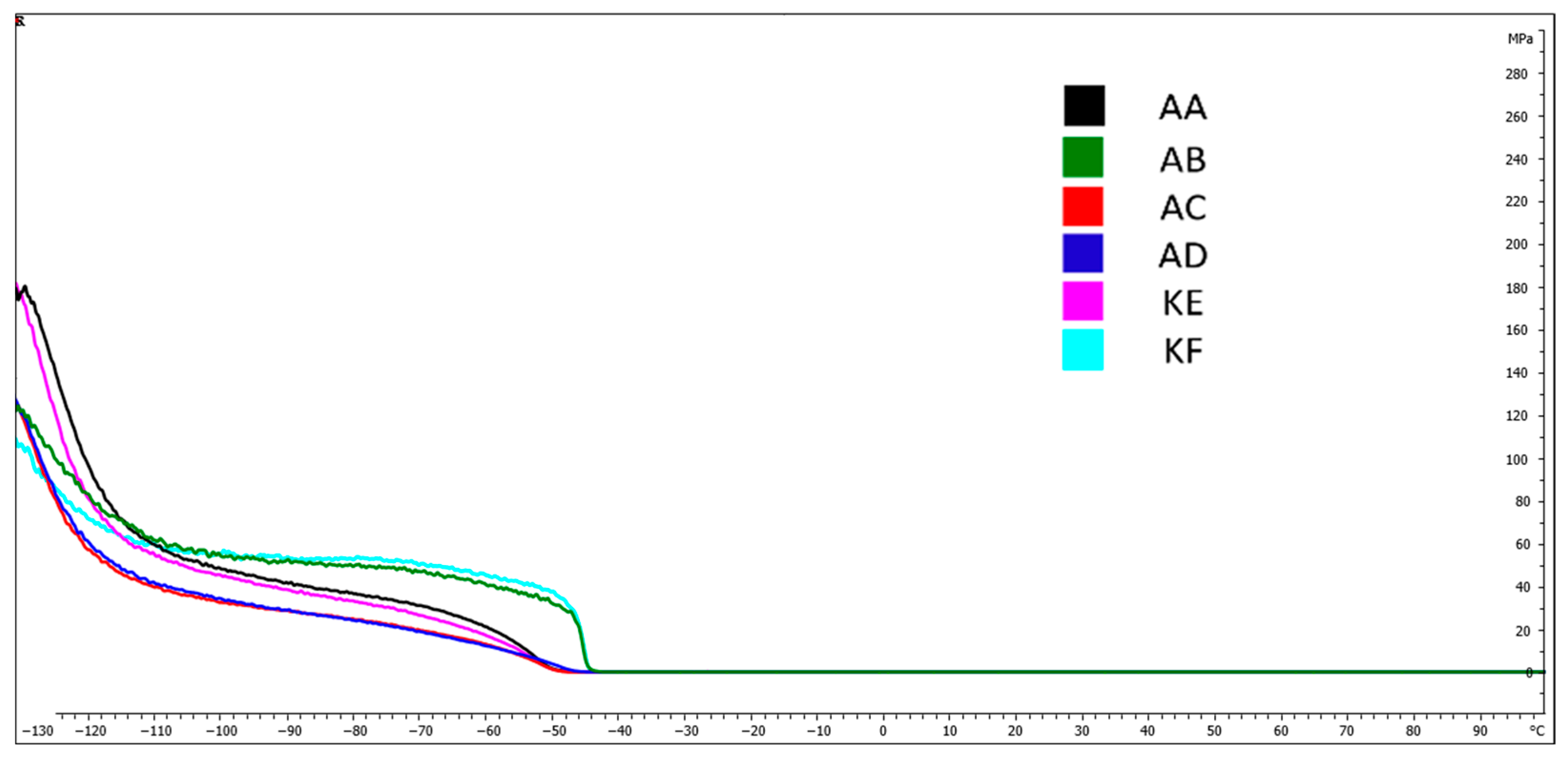
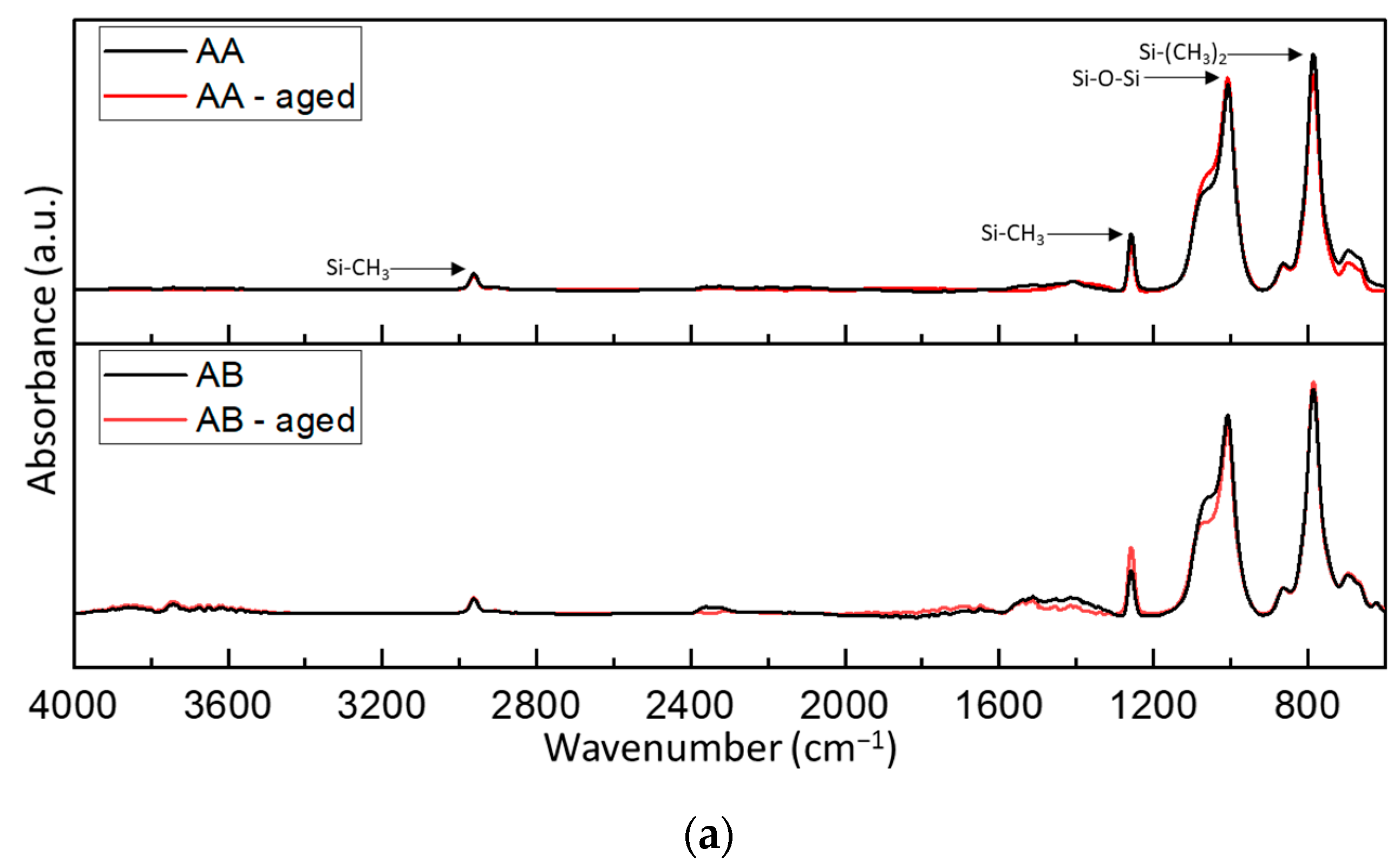
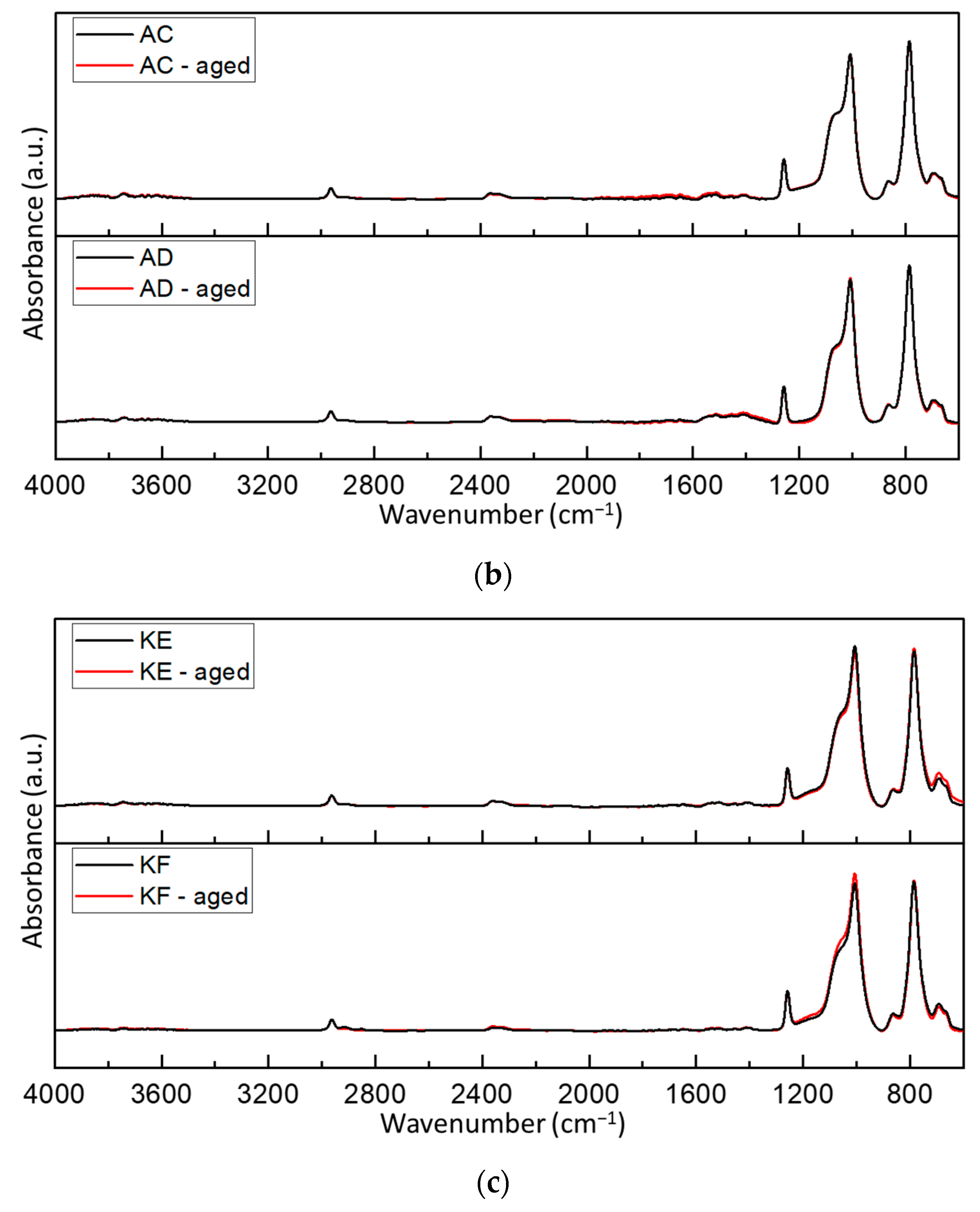
| Properties | Standards | Unit | AA | AB | AC | AD | KE | KF |
|---|---|---|---|---|---|---|---|---|
| Mixing proportion (base:catalyst) | - | - | 100:10 | 100:100 | 100:100 | 100:10 | 100:5 | 100:5 |
| Density 25 °C | ISO 1183 [20] | g/cm3 | 1.12 | 1.17 | 1.08 | 1.08 | 1.19 | 1.2 |
| Brookfield viscosity | - | mPa s | 20,000 | 3700 | 8000 | 35,000 | 25,000 | 35,000 |
| Life time 25 °C | - | min | 60 | 10–12 | 20–22 | 75 | 20–60 | 20–60 * |
| Demoulding time 23 °C | - | h | 16 | 1 | 3 | 24 | 6 | 6 |
| Sample Type | Reference Sample [°C] | Aged Sample [°C] | ||
|---|---|---|---|---|
| Modulus G′ Peak | Modulus G″ Peak | Modulus G′ Peak | Modulus G″ Peak | |
| AA | −112.17 | −108.74 | −111.95 | −108.25 |
| AB | −113.01 | −108.42 | −111.87 | −102.91 |
| AC | −112.88 | −108.09 | −109.75 | −106.81 |
| AD | −112.00 | −105.39 | −114.37 | −110.59 |
| KE | −112.39 | −108.60 | −110.69 | −105.16 |
| KF | −111.20 | −106.76 | −113.04 | −105.37 |
| Sample Type | Reference Sample [°C] | Aged Sample [°C] | ||
|---|---|---|---|---|
| Modulus G′ | Modulus G″ | Modulus G′ | Modulus G″ | |
| AA | −40.94 | −42.05 | −42.05 | −41.08 |
| AB | −43.27 | −42.7 | −42.70 | −41.99 |
| AC | −41.78 | −40.41 | −40.41 | −40.10 |
| AD | −40.19 | −39.72 | −39.72 | −39.11 |
| KE | −38.05 | −37.06 | −37.06 | −37.02 |
| KF | −38.21 | −38.15 | −38.15 | −37.95 |
Disclaimer/Publisher’s Note: The statements, opinions and data contained in all publications are solely those of the individual author(s) and contributor(s) and not of MDPI and/or the editor(s). MDPI and/or the editor(s) disclaim responsibility for any injury to people or property resulting from any ideas, methods, instructions or products referred to in the content. |
© 2023 by the authors. Licensee MDPI, Basel, Switzerland. This article is an open access article distributed under the terms and conditions of the Creative Commons Attribution (CC BY) license (https://creativecommons.org/licenses/by/4.0/).
Share and Cite
Chmielnicka, E.; Szymiczek, M.; Sarraj, S.; Jurczyk, S. Analysis of Thermal Aging Influence on Selected Physical and Mechanical Characteristics of Polyaddition and Polycondensation Poly(dimethylsiloxane). Polymers 2023, 15, 3857. https://doi.org/10.3390/polym15193857
Chmielnicka E, Szymiczek M, Sarraj S, Jurczyk S. Analysis of Thermal Aging Influence on Selected Physical and Mechanical Characteristics of Polyaddition and Polycondensation Poly(dimethylsiloxane). Polymers. 2023; 15(19):3857. https://doi.org/10.3390/polym15193857
Chicago/Turabian StyleChmielnicka, Ewelina, Małgorzata Szymiczek, Sara Sarraj, and Sebastian Jurczyk. 2023. "Analysis of Thermal Aging Influence on Selected Physical and Mechanical Characteristics of Polyaddition and Polycondensation Poly(dimethylsiloxane)" Polymers 15, no. 19: 3857. https://doi.org/10.3390/polym15193857






